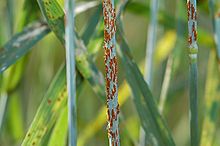
| Puccinia graminis var. Ug99 | |
|---|---|
| Scientific classification | |
| Domain: | Eukaryota |
| Kingdom: | Fungi |
| Division: | Basidiomycota |
| Class: | Pucciniomycetes |
| Order: | Pucciniales |
| Family: | Pucciniaceae |
| Genus: | Puccinia |
| Species: | P. graminis |
| Forma specialis: | P. g. f. sp. tritici |
| Varietas: | P. g. var. Ug99 |
| Trionomial name | |
| Puccinia graminis var. Ug99 | |
| Races | |
|
see text | |
Ug99 is a lineage of wheat stem rust (Puccinia graminis f. sp. tritici), which is present in wheat fields in several countries in Africa and the Middle East and is predicted to spread rapidly through these regions and possibly further afield, potentially causing a wheat production disaster that would affect food security worldwide.[1] In 2005 the noted green revolution pioneer Norman Borlaug brought great attention to the problem, and most subsequent efforts can be traced to his advocacy.[2] It can cause up to 100% crop losses and is virulent against many resistance genes which have previously protected wheat against stem rust.
Although Ug99-resistant varieties of wheat do exist,[2] a screen of 200,000 wheat varieties used in 22 African and Asian countries found that only 5–10% of the area of wheat grown in these countries consisted of varieties with adequate resistance.[1]
The original race of Ug99, which is designated as 'TTKSK' under the North American nomenclature system, was first detected in Uganda in 1998[3] and first characterised in 1999[3] (hence the name Ug99) and has since been detected in Kenya, Ethiopia, Eritrea, Sudan, Yemen, Iran, Tanzania, Mozambique, Zimbabwe, South Africa,[4] and Egypt. There are now 15 known races of Ug99.[5] They are all closely related and are believed to have evolved from a common ancestor, but differ in their virulence/avirulence profiles and the countries in which they have been detected.[1]
- ^ a b c Cite error: The named reference
Singh11was invoked but never defined (see the help page). - ^ a b Gross, Michael (2013). "Pests on the move". Current Biology. 23 (19). Cell Press: R855–R857. Bibcode:2013CBio...23.R855G. doi:10.1016/j.cub.2013.09.034. ISSN 0960-9822. PMID 24251330. S2CID 15559913.
- ^ a b
- • Pretorius, Z. A.; Singh, R. P.; Wagoire, W. W.; Payne, T. S. (2000). "Detection of Virulence to Wheat Stem Rust Resistance Gene Sr31 in Puccinia graminis. f. sp. tritici in Uganda". Plant Disease. 84 (2). American Phytopathological Society: 203. doi:10.1094/pdis.2000.84.2.203b. ISSN 0191-2917. PMID 30841334. S2CID 73469939.
- • Dean, Ralph; Kan, Jan; Pretorius, Zacharias; Kosack, Kim; Pietro, Antonio; Spanu, Pietro; Rudd, Jason; Dickman, Marty; Kahmann, Regine; Ellis, Jeff; Foster, Gary (2012). "The Top 10 fungal pathogens in molecular plant pathology". Molecular Plant Pathology. 13 (4). Wiley-Blackwell: 414–430. doi:10.1111/j.1364-3703.2011.00783.x. ISSN 1464-6722. PMC 6638784. PMID 22471698. S2CID 18505064.
- • Singh, Ravi P.; Hodson, David P.; Huerta-Espino, Julio; Jin, Yue; Bhavani, Sridhar; Njau, Peter; Herrera-Foessel, Sybil; Singh, Pawan K.; Singh, Sukhwinder; Govindan, Velu (8 September 2011). "The Emergence of Ug99 Races of the Stem Rust Fungus is a Threat to World Wheat Production". Annual Review of Phytopathology. 49 (1). Annual Reviews: 465–481. doi:10.1146/annurev-phyto-072910-095423. ISSN 0066-4286. PMID 21568701. S2CID 24770327.
- • Singh, Ravi P.; Hodson, David P.; Huerta-Espino, Julio; Jin, Yue; Njau, Peter; Wanyera, Ruth; Herrera-Foessel, Sybil A.; Ward, Richard W. (2008). "Will Stem Rust Destroy the World's Wheat Crop?". Advances in Agronomy. Vol. 98. Elsevier. pp. 271–309/xiii+422. doi:10.1016/s0065-2113(08)00205-8. ISBN 9780123743558. ISSN 0065-2113. S2CID 55174564.
- ^ Hodson, D. P.; Grønbech-Hansen, J.; Lassen, P.; Alemayehu, Y.; Arista, J.; Sonder, K.; Kosina, P.; Moncada, P.; Nazari, K.; Park, R. F.; Pretorius, Z. A.; Szabo, L. J.; Fetch, T.; Jin, Y. "Tracking the Wheat Rust Pathogens" (PDF). 2012 Borlaug Global Rust Initiative Technical Workshop Proceedings. Borlaug Global Rust Initiative. Archived (PDF) from the original on 5 October 2019. Retrieved 28 November 2012.
- ^ "Pathotype Tracker – Where is Ug99?". The International Maize and Wheat Improvement Center.